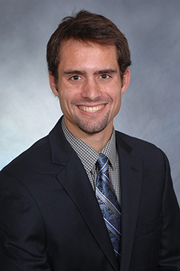Blog: Are the new mRNA vaccines safe?
Wednesday, December 30, 2020

John Lueck
Joanne Ladolcetta, a freelance writer based out of San Francisco, wanted to put together information to help address circulating fears and misconceptions about the recently FDA approved COVID-19 mRNA vaccines. She reached out to friends Bryant Johnson (Cartoonist) and John Lueck (Researcher at the University of Rochester Medical Center) to tackle some of the most common vaccine questions. The collaboration resulted in an approachable informative write-up with creative illustrations and helpful links to provide readers the ability to do a deeper dive into the generation and application of the novel COVID-19 mRNA vaccines.

Courtesy of Bryant Johnson
Brandon Berry and Tyrone Nieves Recognized With Awards at Society for Redox Biology and Medicine Conference
Tuesday, December 1, 2020

Brandon Berry

Tyrone Nieves
Brandon Berry and Tyrone Nieves (Wojtovich lab members) were each recognized with awards at the Society for Redox Biology and Medicine (SfRBM) annual conference. Brandon was recognized with a Young Investigator Award, and Tyrone was recognized with an Undergraduate Research Award. SfRBM focuses on basic and translational research involving the physiology of oxidation and reduction reactions in cells and organisms. A panel of judges chose Brandon and Tyrone based on abstract ranking, presentation and follow-up questions during the conference sessions.
Congratulations to both!
Lara Terry Published in JBC and will present at European Calcium Society General Assembly
Tuesday, November 24, 2020

Congratulations to Lara Terry, who has just had a paper accepted in JBC. Based on this paper she was asked to present a seminar at the European Calcium Society General Assembly plenary session in honor of the memory of Mike Berridge.
The inositol 1,4,5-trisphosphate receptor IP3R is a ubiquitous intracellular Ca2+ release channel which plays fundamental roles in a diverse array of physiological responses. More recently, an ever-increasing number of mutations in the protein have has been reported to be associated with a range of human disease including spinocerebellar ataxia, Gillespie syndrome, peripheral neuropathies and anhidrosis. Lara Terry's thesis project has focused on investigating the mechanisms which underlie alterations of channel function of these mutations. Recently some of her work "Disease associated mutations in Inositol 1,4,5-trisphosphate receptor impair channel function" was accepted for publication in the Journal of Biological Chemistry.
An exciting consequence of the publication is that Lara has been invited to speak at the European Calcium Society "Frontiers in Calcium Signaling" mini symposium in honor of the memory of Sir Michael Berridge, who passed away earlier this year. As many of you know, Mike Berridge is a towering figure in the calcium signaling field having been pivotal in the discovery of IP3 as a second messenger, together with first demonstrating its role to release Ca2+ from intracellular stores. Notably, Lara is one of only six speakers presenting at the meeting, the others being past students of Mike's. Please join us in congratulating Lara on this recognition of her excellent work.
Jarreau Harrison Awarded NIH F31 Ruth L. Kirschstein Predoctoral Individual National Research Service Award
Thursday, November 19, 2020

Congratulations to Jarreau Harrison, graduate student in the laboratory of Dr. Gail Johnson, who was awarded a three-year NIH F31 Ruth L. Kirschstein Predoctoral Individual National Research Service Award entitled, "The role of HSPB8 (HSP22) in maintaining tau proteostsis", beginning September 15, 2020.
Understanding the normal physiological processes that govern the clearance of damaged proteins in neurons is of fundamental importance in the context of age. In this project, Jarreau will determine the role of HspB8 dependent mechanisms in regulating vacuolar dependent degradative pathways and the turnover of tau in neurons. The results his studies will provide foundational information for understanding the mechanisms that contribute to the development of tau pathology in Alzheimer's disease and other neurodegenerative diseases.
Project Summary:
Age is the primary risk factor for numerous neurodegenerative diseases, with Alzheimer's disease (AD) being the most prevalent. During aging there is a decline in protein quality control systems which likely contributes to the formation of the molecular hallmarks of AD; with the accumulation of pathological tau species being a key feature of the disease. Dysfunction of autophagy and mechanisms that promote protein solubility occur early in the pathogenesis of AD. Impairment of these pathways likely contributes to the accumulation and mislocalization of tau, which plays a fundamental role in the pathogenesis of AD. Recent data provide compelling evidence that the stress responsive, small heat shock protein B8 (HspB8) plays a key role in maintaining proteostasis; decreased levels result in increases in insoluble proteins and decreases in autophagy. In addition, a recent study revealed that HspB8 and the multidomain Bcl2 associated athanogene 3 (BAG3) are expressed at higher levels in inhibitory neurons which are more resistant to tau pathology. These findings are very intriguing given that HspB8 is a key binding partner of BAG3, and thus they may work together to promote tau proteostasis. Further, our preliminary data suggest that HspB8 likely plays a key role in maintaining tau solubility and promoting autophagy. The UNDERLYING PREMISE of this proposal is that in neurons HspB8 plays a critical role in mediating tau solubility and autophagy, and thus the turnover of tau. The importance of HspB8 in mediating neuronal proteostasis is illustrated by the fact that previous findings indicate that HspB8 facilitates the autophagic clearance of disease relevant, aggregate prone proteins such as truncated TDP-43 species. Nonetheless, our understanding of how HspB8 regulates tau clearance and solubility is very limited. CRITICAL KNOWLEDGE GAPS include: how HspB8 levels affect tau solubility and accumulation, the role of HspB8 in modulating autophagic flux/ autophagosome-lysosome fusion, and if the expression level of HspB8 in neuronal populations correlates with their relative susceptibility to tau pathology. Considering these critical knowledge gaps the OVERALL HYPOTHESIS of this proposal is that HspB8 plays a role in maintaining tau solubility and facilitating autophagic flux, and thus tau clearance. In the context of this overall hypothesis the specific aims of this proposal are: (1) To test the hypothesis that HspB8 mediates tau solubility and autophagic flux and thus contributes to tau clearance in a BAG3 dependent manner, (2) To test the hypothesis that HspB8 is differentially expressed in inhibitory and excitatory neurons which plays a role in determining susceptibility to tau pathology, and (3) To test the hypothesis that HspB8 protects neurons from tau pathology in vivo. The majority of these studies will be carried out using primary neuron cultures and mouse models. All in vivo studies will be carried out in older male and female mice since age likely influences the effects of HspB8. The IMPACT of these studies will be to provide crucial new insights into the mechanisms by which HspB8 protects against tau accumulation and facilitates turnover by autophagy to maintain a healthy neuron.
Karl Foley, Receives NIH F30 Award
Thursday, November 19, 2020
Karl Foley, an MSTP graduate student, has received an NIH F30 award starting Feb 1, 2020 for his research in the Xia lab.
Project title: "Protein phosphatase 1 isoforms and human de novo mutations in synaptic plasticity"
Agency: NIMH (F30MH122046), $50K total/year for four years starting 2/1/2020
Congrats Karl!
Special Department of Microbiology and Immunology Seminar – Dr. Malika Grayson – November 9th at NOON
Friday, October 23, 2020
How do you make an impact when you are the only person in the room that looks like you? We hear the terms diversity and inclusion but forget that the term representation should be a reflection of diversity and inclusion combined. This isn't always the case. Dr. Grayson discusses her views on what it means to increase diversity and representation as an Individual Contributor. Learn more about her journey as the 2nd Black Woman to graduate with a PhD in Mechanical Engineering from her graduate institution. Hear about her current work as both an engineer, a STEM Advocate, and her most recent success as author of 'HOODED: A Black Girl's Guide to the PhD' where she highlights her time and lessons learned during her PhD Program.

Miriam Barnett is the Molecular Pharmacology Highlighted Trainee for October
Thursday, September 24, 2020
Miriam Barnett, M.S. (Bidlack Lab) is the Molecular Pharmacology Highlighted Trainee for October in The American Society for Pharmacology and Experimental Therapeutics (ASPET). Ms. Barnett is a pre-doctoral scientist in the Department of Pharmacology and Physiology at the University of Rochester under the mentorship of Dr. Jean M. Bidlack. The Molecular Pharmacology article that earned her selection as a Highlighted Trainee Author is titled "Unique Pharmacological Properties of the Kappa Opioid Receptor Signaling Through Gαz as Shown with Bioluminescence Resonance Energy Transfer" and is available at https://doi.org/10.1124/mol.120.119404.
Congratulations Miriam!
Dr. Robert Freeman Selected As 2020 Outstanding Graduate Course Director
Tuesday, September 1, 2020
Dr. Robert Freeman has been selected as this year's recipient of the Outstanding Graduate Course Director Award. Established in 2013, this award is based on the course's record of excellence based on course-instructor survey evaluations and letters of recommendation from students enrolled in the course.
This award comes with $1,000, to be paid as unrestricted education support monies (for education-related expenses such as travel to professional meetings, work-related computers, textbooks, courses, etc.) and is available immediately.
The award will be presented at the School of Medicine and Dentistry Convocation Ceremony. The Virtual Convocation Celebration will be posted to the following websites at 5pm on Monday, September 14th:
- https://www.urmc.rochester.edu/education/graduate.aspx
- https://www.urmc.rochester.edu/education/md.aspx
- https://www.urmc.rochester.edu/education.aspx
- https://www.urmc.rochester.edu/smd.aspx
The department would like to congratulate Bob on this recognition, as it is a well-deserved honor.
Halima Aweis Wins Graduate Alumni Fellowship Award
Tuesday, September 1, 2020
Halima Aweis has been selected by our faculty to be one of this year's recipients of the Graduate Alumni Fellowship Award. Graduate alumni in the School of Medicine and Dentistry established this fellowship award to recognize an incoming graduate student's promise for exceptional accomplishment in graduate study.
The award, which includes a monetary prize of $500, will be presented at the School of Medicine and Dentistry Convocation Ceremony. The Virtual Convocation Celebration will be posted to the following websites at 5pm on Monday, September 14th:
- https://www.urmc.rochester.edu/education/graduate.aspx
- https://www.urmc.rochester.edu/education/md.aspx
- https://www.urmc.rochester.edu/education.aspx
- https://www.urmc.rochester.edu/smd.aspx
Congratulations Halima!
Romeo Blanc Selected to be this year’s recipient of the Outstanding Postdoctoral Researcher Award
Tuesday, September 1, 2020
Post-doctoral associate, Romeo Blanc, in the lab of Dr. Joe v. Chakkalakal has been selected to be this year's recipient of the Outstanding Postdoctoral Researcher Award. This award was established in 2015 to recognize a School of Medicine and Dentistry postdoc for outstanding research contributions. The selection was based on the originality, creativity, and significance of your research accomplishment.
The award will be presented at the School of Medicine and Dentistry Convocation Ceremony. The Virtual Convocation Celebration will be posted to the following websites at 5pm on Monday, September 14th:
- https://www.urmc.rochester.edu/education/graduate.aspx
- https://www.urmc.rochester.edu/education/md.aspx
- https://www.urmc.rochester.edu/education.aspx
- https://www.urmc.rochester.edu/smd.aspx
Congratulations on being chosen for this award, Romeo!
Chakkalakal Lab Publishes Study on Muscle Regeneration in Nature Communications
Thursday, August 20, 2020
A new study published in Nature Communications provides insight into why older individuals take longer than younger people to heal following muscle injuries from a fall or exercise. Led by Joe V. Chakkalakal, Ph.D., Dean's Associate Professor in the Department of Pharmacology and Physiology and Roméo Blanc, Ph.D., postdoctoral fellow in Chakkalakal's lab, the study also highlights a potential path to speed muscle regeneration and strength recovery in older adults.
When any individual (young or old) sustains a muscle injury there's an inflammatory response. This response is prolonged in aged tissue and interferes with the ability of stem cells to heal the tissue. The research team discovered that a pathway that's known to be active in inflammatory cells -- the CCR2 pathway -- is also expressed in muscle progenitor cells. They found, unlike in young mice, persistent activation of CCR2 signaling in muscle progenitor cells in older mice after acute injury. Opportune inhibition of CCR2 post-injury enhanced aged regeneration and functional recovery in the mice.
"The CCR2 pathway is well known, but no one thought of looking for it or studying it in non-inflammatory cells," said Chakkalakal, the corresponding author of the study. "We connected the entire pathway and found exactly how it is preventing the differentiation of progenitor cells into mature muscle in older animals."
"Currently, the studies dedicated to understanding what causes delays in aged muscle recovery from injury are lacking. This project was especially challenging because we had to demonstrate that the inflammatory response through Ccr2 directly affected muscle progenitor cell function, while most of the field ignored that possibility," added Blanc, the first author of the study. "I believe that this study is an important step to help develop ways to restore older people's muscle strength after an injury, but could also improve stem cell-based therapy in the elderly where high inflammation and aberrant immune response is a known issue."
Next, the team plans to study how manipulating this pathway could supplement the beneficial effects of exercise on aged muscle. They are also interested in learning about the role this pathway plays in pediatric cancer survivors, who experience accelerated aging and muscle loss.
The study was funded by the National Institutes of Health. In addition to Drs. Chakkalakal and Blanc, Jacob Kallenbach, John Bachman, Amanda Mitchell and Dr. Nicole Paris contributed to the study.
GDSC Predoc Tom O’Connor Passes his Qualifying Exam!
Thursday, August 20, 2020
 Having recently completed his second year, earlier this month, GDSC Predoc Tom O'Connor passed his Qualifying Exam. Tom is pursuing his Ph.D. research under a co-mentorship with Dr. Robert Dirksen and Dr. Joe Chakkalakal. His doctoral research project is titled "Endurance exercise as a therapeutic intervention to preserve skeletal muscle function post-radiation." His research abstract is sampled below. Congratulations Tom!
Having recently completed his second year, earlier this month, GDSC Predoc Tom O'Connor passed his Qualifying Exam. Tom is pursuing his Ph.D. research under a co-mentorship with Dr. Robert Dirksen and Dr. Joe Chakkalakal. His doctoral research project is titled "Endurance exercise as a therapeutic intervention to preserve skeletal muscle function post-radiation." His research abstract is sampled below. Congratulations Tom!
Abstract: Exercise has several beneficial effects on overall health, such as increased bone strength and improved cardiovascular, cognitive, and immune system function. Similarly, exercise elicits improved muscle function by increasing muscle stem cell (satellite cell, SC) activation and improving excitation-contraction coupling through the establishment of Ca2+ Entry Units (CEUs) and upregulation of calcium handling genes. However, radiotherapy, a mainstay in the treatment of many cancers, produces multiple adverse effects on skeletal muscle and has been shown to cause early-onset sarcopenia, a condition characterized by significant muscle weakening commonly observed in the elderly. Our studies show that radiation produces cytotoxic effects on SCs, depleting the SC pool and leaving the remaining SCs dysfunctional in their ability to activate and repair injured myofibers. We find that radiation exposure also decreases expression of key Ca2+ handling genes in skeletal muscle including CASQ1, CACNB1, and STIM1. Calsequestrin-1 binds Ca2+ in the sarcoplasmic reticulum (SR), buffering intracellular Ca2+ stores upon muscle excitation-contraction. CACNB1 encodes the b subunit of the 5 subunit dihydropyridine receptor (DHPR), the voltage sensor in the transverse tubule (TT) that activates ryanodine receptor (RyR1) in the SR to release Ca2+ for muscle contraction. STIM1 encodes the stromal-interaction molecule-1, a Ca2+ sensor in the SR, which activates Orai1 Ca2+-permeable channels in the TT when SR Ca2+ stores become depleted, a process known as store-operated calcium entry (SOCE).
The central hypothesis of this project is that post-radiation exercise restores muscle repair and regeneration function through activation of the remaining SC pool, allowing for turnover of damaged myonuclei. We also postulate that endurance exercise restores homeostatic Ca2+ control mechanisms after radiation through upregulation of integral Ca2+ handling genes and establishment of CEUs, overall restoring post-radiation muscle contractile function. I will assess the effect of post-radiation chronic endurance exercise on physiological muscle function using a juvenile radiation mouse model. Aim 1 will characterize SC adaptation in terms of myonuclear contribution and regenerative function post-voluntary wheel running (VWR), the model we will use for chronic endurance exercise. Aim 2 will address how Ca2+ handling is affected by VWR, assessing SOCE, gene expression, and resting calcium levels. Aim 3 will address the effects of radiation on SCs and Ca2+ handling and the therapeutic extent of post-radiation VWR to restore physiological muscle function. The results of these studies will provide novel insight into the patho-mechanisms of radiation-induced sarcopenia and determine the therapeutic potential of chronic endurance exercise to rescue SC regenerative capacity and enhance Ca2+ handling in an attempt to restore overall muscle function.
Jacob Kallenbach awarded a Wilmot Cancer Institute predoctoral fellowship
Friday, June 12, 2020

Jacob Kallenbach
Congratulations to PhD Candidate Jacob Kallenbach (Chakkalakal Lab), who was awarded a Wilmot Cancer Institute predoctoral fellowship to support his proposal on "Targeting CCR2 to Mitigate the Late Effects of Juvenile Radiation-Induced Skeletal Muscle Decline."
He will investigate how adult survivors of childhood cancers are at an increased risk of diminished physiological musculoskeletal function, which is intricately connected to a survivor's quality of life. Jacob will exploit his lab's preclinical mouse model to study the early and late effects of juvenile radiation therapy, which comprises >50% of cancer therapies, on skeletal muscle tissues. The data from his study will be used to describe an inflammatory-mediated C-C chemokine receptor 2 (Ccr2) mechanism, where its inhibition could augment the functional quality of life of childhood cancer survivors.
The Wilmot Predoctoral Cancer Research Fellowship provides two years of support for Ph.D. or M.D./Ph.D. candidates under the mentorship of a Wilmot Cancer Institute member. The goal of the program is to enable emerging scientists to build an independent career in the investigation of the causes, diagnosis, treatment, prevention, or management of cancer or its side effects.
Matthew Rook awarded a Joan Wright Goodman Dissertation Fellowship
Monday, June 1, 2020
Matthew L. Rook, M.S. (MacLean Lab) has been awarded a Joan Wright Goodman Dissertation Fellowship for 2020-2021! This fellowship was endowed by Joan Wright Goodman, PhD class of 1952, to support doctoral students across disciplines in the sciences. It is one of the University's most competitive dissertation fellowships and is given to students who display exceptional ability and promise. It is a testimony to the University's commitment to supporting your scholarship.
The award is $20,000, and must be used over at least 9 months between July 1, 2020 and June 30, 2021. Congrats Matthew!
Meet Alexander Milliken: A School of Medicine and Dentistry Ambassador
Tuesday, February 4, 2020
Third year PhD student thrives on pushing boundaries

Alexander Milliken
Alexander Milliken thrives on being challenged, pushing boundaries, and building community. He's a third year graduate student at the School of Medicine and Dentistry (SMD), where he is pursuing a PhD in pharmacology.
Milliken is also part of SMD's Ambassador Program, which connects current medical students, trainees, and PhD candidates with alumni through events, programs, tours, and other activities. Milliken and the other 27 SMD Ambassadors provide alumni a glimpse into the experience of current students and, in turn, alumni provide insights into their medical careers. "Being an ambassador gives me valuable volunteer experience," Milliken says. "It helps me sharpen my leadership skills and make personal and professional contacts." Milliken has met like-minded peers through the program, too—people he wouldn't have met otherwise. And, he's taken the concept of a multidisciplinary approach to a new level. For instance, he rock climbs with colleagues from immunology, microbiology, and virology. He works out at the River Campus fitness center with friends from neuroscience, pharmacology and toxicology. He plays in a softball league with biomedical engineering students, and he's on a volleyball team with peers from biochemistry and biophysics.
When did you know you wanted a career in medicine? I always knew I wanted to pursue a career in medicine but after losing both my grandfather and one of my best friends to cardiac-related deaths, the decision was clear to start my career in research, pushing the boundaries of what we think we know.
Why cellular and molecular pharmacology? I was drawn to cellular and molecular pharmacology physiology because of the strong mitochondria research group. I can study the underlying molecular mechanisms of a pathology such as heart attack and then can begin to develop/screen novel therapeutics that could one day potentially make their way into the clinic. Mitochondria are the source of energy production in the cell and are starting to gain a significant amount of attention for their implications in many other diseases, pathologies, and syndromes.
Why did you want to go to the School of Medicine and Dentistry? I grew up in Rochester. I love it here and although I left the area for my undergraduate studies, SMD was my number one choice throughout the graduate school application process. The school is focused on answering rigorous scientific questions and sets the standard for how research should be done. The hospital, medical school, and graduate school are all under one roof, which allows for extensive collaboration among a vast array of research fields.
Why did you want to be an SMD Ambassador? Being an ambassador means that I am part of the group that helps connect generations of people associated with the University. We are all so lucky to be a part of the community here.
What do you enjoy most about being an Ambassador? A lot of the alumni I've met are MDs, not PhDs like me. What's clear to me is that although our paths have been very different, there are a lot of similarities, including the rigorous training and the tremendous rewards of such hard work. We all share one thing in common: the University of Rochester experience. I particular enjoy how much the MDs are genuinely interested in PhD research when I have had the opportunity to talk with them at various networking events.
What's a typical day like for you? Each day usually starts with responding to emails, checking for any new publications on PubMed, and finishing up calculations. Then, I will start an experiment, for instance, something related to surgery or mitochondria or cardiac cell isolation. After that, I analyze data from the experiment to see which direction the day has pushed me toward and where I need to focus my work tomorrow.
Suzanne Haber Honored by Society of Biological Psychiatry for Research on Mental Disorders
Thursday, January 30, 2020
Suzanne N. Haber, Ph.D., Dean's Professor in the Department of Pharmacology and Physiology, will receive the Society of Biological Psychiatry's 2020 Gold Medal Award at the Society's 75th Annual Scientific Convention & Meeting in the spring. The award honors members of the Society whose significant and sustained work has advanced and extended knowledge on the neurobiology of mental illness.
Haber's lab investigates the cortico-cortical and cortico-basal ganglia systems in the brain. Her work demonstrates the specific hard-wired connections that are associated with normal decision making, emotional and cognitive control, and the connectional abnormalities in those circuits that are linked to a wide range of mental health disorders, including obsessive-compulsive disorder (OCD), drug abuse and addiction, schizophrenia, and motor control disorders such as Parkinson's disease. This work has played a key role in targeting and interpreting the effects of noninvasive and invasive therapeutic approaches for OCD and depression.
For the past ten years, Haber has led the Silvio O. Conte Center for Basic and Translational Mental Health Research at the University of Rochester. Funded by the National Institute of Mental Health, the Center uses translational approaches to probe the neurocircuitry that underlies neuromodulation for OCD, pinpointing specific abnormalities within the brain circuits that are associated with the disease. This information is being used to guide new treatment options for the three million-plus Americans who live with the disorder.
"Suzanne's seminal contributions to elucidating specific neural networks that control learning, decision-making, reward and motivation, and how pathologies associated with these neural communication hubs underlie multiple neurological, movement, and mental health disorders make her uniquely qualified to receive this prestigious career award," said Robert T. Dirksen, Ph.D., Lewis Pratt Ross Professor and Chair of the Department of Pharmacology and Physiology. "Her work is making a difference in the lives of individuals and families suffering from neurological and mental health disorders. We are extremely proud that she represents the University of Rochester as a Society of Biological Psychiatry Gold Medal Award winner."
The Society of Biological Psychiatry was founded in 1945 to emphasize the medical and scientific study and treatment of mental disorders. It's the oldest neuropsychiatry research society in America, currently made up of more than 1,500 members from across the United States, Canada, Europe and Asia. Members conduct research in areas spanning from basic cellular studies to clinical trials and prevention research.
Haber, who is also a professor of Neuroscience, Brain and Cognitive Science, and Psychiatry, will split the 2020 Gold Medal Award with Carol Tamminga, M.D. of UT Southwestern Medical Center.
Jing Liu awarded a two-year American Heart Association predoctoral fellowship
Thursday, January 9, 2020
Jing Liu, graduate student in the laboratory of Dr. David A. Dean was awarded a two-year American Heart Association predoctoral fellowship entitled, "Role of MRCKa and Na+,K+-ATPase signaling in alveolar barrier function in the mouse lung", beginning January 1, 2020.
Project Summary:
Acute Respiratory Distress Syndrome (ARDS) is a severe medical condition which is characterized by significant alveolar fluid accumulation and insufficient gas exchange. Cardiac surgery, ECMO, and use of cardiac medications are all known risk factors for ARDS which also complicates management of these and other cardiovascular diseases. Effective alveolar fluid clearance and repair of a functional alveolar-capillary barrier are considered the primary mechanisms for edema resolution in ARDS. Apart from enhancing fluid clearance, the Na+,K+-ATPase has been shown important for alveolar barrier function. Our lab showed that overexpression of the Na+,K+-ATPase b1 subunit into lungs enhances alveolar barrier integrity in previously injured lungs in mice and pigs. Previous in vitro data indicated that MRCKa mediates the upregulation of tight junction (TJ) proteins and epithelial barrier integrity by b1 overexpression. I hypothesize that the b1-Na+,K+-ATPase regulates alveolar barrier function through MRCKa in vivo. I will determine 1) whether MRCKa is required for the upregulation of TJ proteins and barrier function by b1 gene delivery in vivo, and 2) whether overexpression of MRCKa alone is sufficient to protect and/or treat lipopolysaccharides (LPS) induced lung injury in mice. LPS will be delivered by oropharyngeal aspiration to induce lung injury. Various plasmids will be delivered to mouse lungs by electroporation. For aim 1, plasmid to knockdown MRCKa or an MRCKa inhibitor will be delivered to lungs 24 hours before gene transfer of plasmid to overexpress b1. If required for signaling, MRCKa knockdown or inhibition will abolish b1's induction of TJ proteins and barrier upregulation. For aim 2, mice will be challenged with LPS 24 hours after (protection study) or before (treatment study) gene transfer. At end points, various assays will be performed to assess lung injury. It is expected that overexpression of MRCKa alone will be sufficient to protect and treat LPS induced acute lung injury, decreasing lung injury and increasing TJ expression; overexpression of both MRCKa and b1 subunit will augment the protection and treatment of LPS injured lungs to give the greatest reduction in lung injury and improvement in barrier function. These studies will increase our understanding of the pathogenesis and treatment of ARDS, improve lung health, and ultimately decrease cardiovascular complications.
Chongyang Zhang awarded a two-year American Heart Association predoctoral fellowship
Monday, January 6, 2020
Chongyang Zhang, graduate student in the laboratory of Dr. Chen Yan was awarded a two-year American Heart Association predoctoral fellowship entitled, "The role of PDE1C in vascular smooth muscle cell lysosomal dysfunction and atherosclerosis", beginning January 1, 2020.
Project Summary:
The objective of this project is to investigate the function and underlying mechanism of the cyclic nucleotide phosphodiesterase 1C (PDE1C) in pathological vascular remodeling during atherogenesis. Cyclic AMP and cyclic GMP regulate vascular functions. PDEs by hydrolyzing cyclic nucleotides, regulate cyclic nucleotide signaling. Vascular smooth muscle cells (SMCs), upon endothelium damage, transit from contractile phenotype to synthetic phenotype. In vasculature, PDE1C expression is selectively induced in synthetic SMCs, but not in contractile SMCs or endothelial cells. Synthetic SMCs can accumulate oxidized low-density lipoprotein (oxLDL) in lysosomes, referred to as SMC-derived foam cells, that have been suggested to contribute significantly in atherosclerotic lesions. oxLDL accumulation in lysosome causes lysosome membrane permeabilization and lysosome dysfunction, which accelerates atherosclerosis progression. Our preliminary data demonstrate PDE1C deficiency significantly decreases atherosclerotic lesions in vivo. In synthetic SMCs in vitro, we found that PDE1C inhibition reduces lysosomal oxLDL accumulation and ameliorates lysosomal permeabilization. Therefore, we propose two specific aims. Aim1: Determine the roles and underlying mechanisms of PDE1C in the regulation of oxLDL accumulation and lysosomal permeabilization in synthetic SMCs in vitro. In SMCs culture, PDE1C deficiency will be examined by PDE1 activity inhibitor, PDE1C wildtype vs PDE1C knockout mouse SMCs, PDE1C shRNA, and PDE1C reconstitution by adenovirus. SMCs oxLDL accumulation and lysosomal permeabilization will be assessed by Acridine Orange staining, cathepsin B/D staining, and lysosomal galectin puncta assay. Underlying mechanistical studies will use pharmacological inhibitors, siRNA or shRNA. Aim2: Evaluate the effect of PDE1C deficiency on SMC lipid accumulation and lysosomal dysfunction in atherosclerotic lesions in vivo. We will use spontaneous atherosclerotic model induced by 4 months high fat diet in mouse for biochemical assessments in the lesion areas.
We will also examine the treatment potential of PDE1 inhibition on pre-trapped lipid deposition, using an accelerated atherosclerosis mouse model induced by carotid artery partial ligation. We hypothesize that PDE1C plays an essential role in atherosclerotic vascular modeling by promoting oxLDL induced-lysosomal dysfunction in synthetic SMC. This study may have significant therapeutic impact on atherosclerosis treatment.